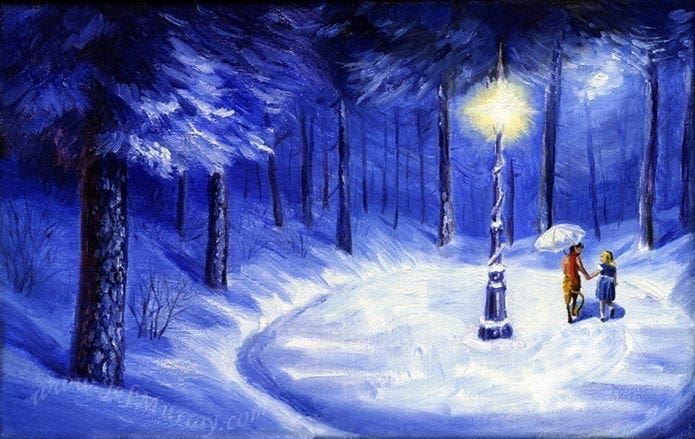
Crossing the boundary into a magical kingdom
By LORRAINE V. MURRAY, Commentary | Published December 7, 2017
“You made a good reindeer,” my aunt said to me.
“Did you get down on your hands and knees?” my cousin inquired.
“No, it was more of a crouched-over version,” I replied.
I’d arrived from the airport earlier that day to find Brody, 7, pretending to be Santa with his sister, Aubree, 5, as Mrs. Claus.
My aunt was sitting with the children on the patio, and when I walked out, they evidently figured I’d make a decent reindeer, so they invited me to join them.
Soon I was hunched over with my hands affixed to my head, suggesting antlers. And in that moment, I quietly crossed the border into the children’s imaginary world.
I sensed the magical changes that happened when Lucy stepped into the wardrobe in C.S. Lewis’ “The Lion, the Witch and The Wardrobe.”
As readers of the tale know, she entered Narnia, a magical realm where she meets a faun named Mr. Tumnus.
Because she’s trusting, Lucy believes his intentions are harmless, so she accepts his invitation to have tea at his home.
In fact, the wicked witch had instructed Mr. Tumnus to capture a human child, but faced with the innocent, sweet Lucy, he has a change of heart and lets her go.
Back in my own imaginary realm, I galloped across the patio with Santa cheering me on.
Mrs. Claus was eager to feed me invisible carrots, which I dutifully devoured, although I also requested cookies. At this point, however, it seems I’d broken some unspoken rule.
“Reindeer,” said Santa firmly, “don’t eat cookies.”
“But I’m an imaginary reindeer,” I countered. “So I can eat whatever I want.”
Both children mulled this over, and seemed to find my suggestion plausible.
While Mrs. Claus handed me sugary treats, Santa began hitting me with a Styrofoam pool device known as a “noodle” to make me go faster.
I drew myself up to my full height of 5’2” and, frankly, was pleased that I towered over my companions, since this rarely happens in the adult world.
“Hitting is not in my contract,” I protested.
At that moment, the children’s grandmother, my cousin Julie, came outside to announce Brody had homework to finish.
With great reluctance, Santa morphed back into an ordinary boy, and followed her inside.
We know Jesus especially loved little boys and girls, since he said, “Let the little children come to me, and do not hinder them, for the kingdom of heaven belongs to such as these.”
Children have innate humility because they’re well aware of their limitations. They depend on adults to cook their food, bandage their wounds and chase monsters from beneath the bed.
In “Wood of the Cradle, Wood of the Cross,” Caryll Houselander says Jesus invites us to become like little children—not adolescents.
As she puts it, a child—until the age of 10—has the capacity for total joy and complete surrender.
“An ordinary child, who has not been warped by ill treatment or spoiling is … a more complete human being than he will ever be again.”
Little children don’t judge toys by price tags, and they trust adults beyond the shadow of a doubt.
They give their hearts without reservation, and they need love to thrive.
When I was little, I would turn to my sister and say, “Make believe we’re horses and the bad guys are chasing us in the desert.”
In seconds, we’d be thundering barefooted across the grass under the branches of palm trees—because our desert, you see, was actually our yard in Miami.
At some point, every child crosses the boundary between innocence and adulthood. They stop playing make-believe; they stop becoming horses.
They worry about their looks, want more expensive toys and grow concerned about other people’s opinions.
Christ said heaven was tailored for children, and Narnia gives us a glimpse of what it’s like.
But so can an ordinary day on a patio with everyday children—if you step through the secret portal.
And perhaps we’ll meet fauns and talking horses in heaven—and don’t forget reindeer eating cookies to their hearts’ content.
Artwork by Jef Murray. His website is www.jefmurray.com. Lorraine Murray’s address is lorrainevmurray@yahoo.com.